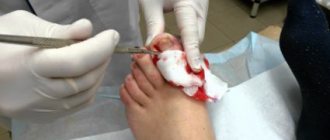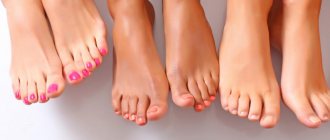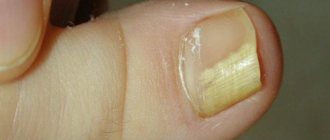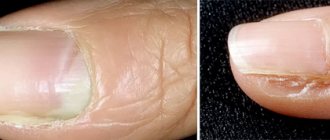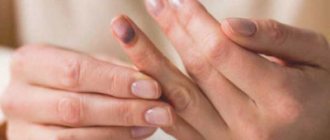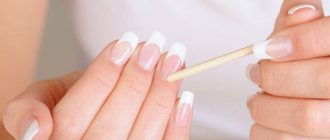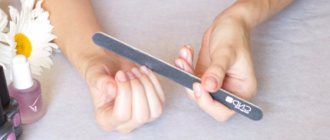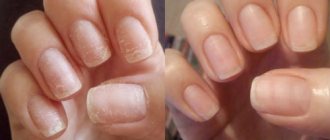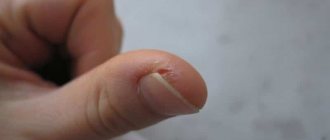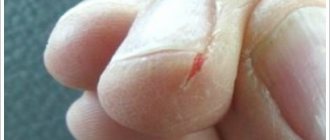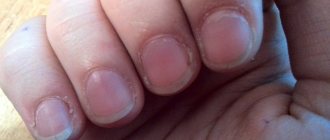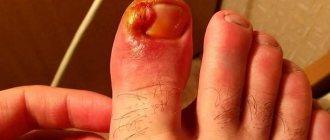Indications for nail plate removal
Onychomycosis occurs differently in everyone - the symptoms are mild in some and the disease practically does not bother the person, while in others the surface of the nail is changed beyond recognition, the pain syndrome is very pronounced. If signs of infection reduce people’s quality of life, mycologists decide to remove nail fungus surgically/hardware.
Main indications for the procedure:
- preventing the spread of the disease to neighboring, healthy tissues;
- damage to the nail plate by 70–90%;
- the need to accelerate the therapeutic course of action on the fungus;
- lack of positive effect from several drug treatment regimens;
- pronounced ingrown nail;
- detection of a focus of suppuration under the nail plate;
- diagnosed infection of the root of the finger;
- the need for the prevention of bacterial complications;
- pronounced unaesthetic appearance of the nail;
- frequent relapses of onychomycosis.
The absolute indication for removing a toenail due to fungus is its complete destruction in severe cases of the disease. Especially if the patient is intolerant to most pharmaceutical drugs with fungicidal properties.
Why do you need to remove the nail plate?
At the moment, there are a lot of medications for nails affected by fungus. Among them are varnishes, gels, creams, solutions. Before using them, removal of the nail plate is often prescribed. This is necessary for the following purposes:
- Preventing the spread of infectious processes on the skin;
- Prevention of bacterial complications;
- Improving the absorption of drugs into the site of infection;
- Reducing the time required to complete a treatment course.
If you have been prescribed such a procedure, do not be afraid of it. A healthy nail will grow in place of the damaged plate.
Preparing for removal
Before proceeding with the removal of the nail plate, which is affected by fungal microorganisms, mycologists talk with the patient about the need for preoperative preparation of the feet. This allows you to avoid severe pain and facilitates the removal of tissues altered by infection.
The first stage of preparation is baths before removing a nail with fungus . Steaming changes the structure of the nail plate, making it easier to separate from the underlying layers. For this purpose, saline solutions, chamomile teas, or soap concentrates with tar soap have proven themselves to be excellent. It is necessary to perform a bath every evening, lowering your feet for 20–30 minutes in a container with the prepared product.
After thoroughly drying the tissues with a paper towel, they begin to remove the top layer - carefully trim the edge of the plate with individual nail scissors, and clean the softened cells with a nail file or a special scraper.
Any questions that arise - how to remove a nail affected by fungus, whether it is possible to steam your feet with nail fungus - are best asked to a mycologist during a consultation. After all, independently removing a nail affected by a fungus is far from a simple procedure. Sometimes complications arise.
Methods for removing an infected nail
The doctor, after carefully examining the area affected by the fungal infection and conducting diagnostic tests, will have a conversation with the patient about whether it is necessary to remove the nail if the fungus is present. In severe, chronic, advanced cases of the disease, it will not be possible to avoid this option of combating the pathology. But you can choose one of several existing methods of intervention - surgical, hardware or medication. Each has its own characteristics, indications and contraindications. Only a doctor can decide which method of removing nail fungus will be best for each patient.
Surgical method
For several decades, specialists have resorted to removing the entire surface of the nail plate if it is completely affected by fungal microorganisms. This is a somewhat outdated technique, but still effective. It guarantees an absolute cessation of further spread of the disease and localizes the acute inflammatory process within one finger.
Immediately before the procedure, the doctor performs local anesthesia - injects an analgesic solution. Most often, fungus on the big toe can be removed surgically:
- the surface of the plate is disinfected with iodinol - completely covering the entire affected area and adjacent tissue areas with the solution;
- the base of the finger is pinched with a tourniquet;
- use instruments to pry up the nail plate;
- carefully separate it;
- the open wound surface is treated with an agent with antibacterial properties;
- apply an aseptic dressing.
Subsequently, the dressings are changed 2-3 times a day until the wound is completely healed, in order to avoid the penetration of a secondary infection. It takes up to 4–6 months for a healthy nail to grow back. The method is very traumatic, complications arise frequently. Therefore, it is practically not practiced recently.
Hardware method
A more gentle option on how and where you can remove a nail affected by a fungus is to visit a beauty salon with a hardware pedicure room. A specialized medical procedure involves layer-by-layer removal of the nail plate, right down to the tissues of the nail bed. The technique is practically painless and as safe as possible if all instructions are followed.
The required result can be achieved in one visit to a specialist. Stages of hardware removal of a nail with fungus:
- First, the affected area is treated with a special tissue softening agent;
- apply an antiseptic;
- select a suitable nozzle for the device;
- begin to remove the nail plate - cutting off layer by layer;
- cover the treated finger with a protective bandage.
This type of removal has many benefits. Among them, the most important are bloodlessness, painlessness, low risk of secondary infection, as well as quickly obtaining the required result.
Laser removal
A modern option to remove a nail affected by fungus without surgery is to use a laser machine in a specialized medical office. The effect will be maximum, both in terms of quality and level of safety for human health. Almost the only drawback is its high cost.
The bottom line is this: the heat wave penetrates the layers of the nail plate and dries out the areas affected by fungal microorganisms. Waves can have different lengths, as well as temperature intensity. Typically, the session lasts 5–7 minutes. Their total number will vary - about 4-6 times, in direct proportion to the severity of the disease.
Among the contraindications to laser treatment of onychomycosis, experts indicate:
- pregnancy period followed by lactation;
- acute infections in the area of the upcoming intervention;
- tissue neoplasms;
- blood diseases and atherosclerosis.
In general, the technique deservedly enjoys the respect of mycologists; it has proven itself to be effective in cases of severe onychomycosis.
Application of creams and ointments
Not all people decide to entrust their nails to strangers, so they are looking for ways to remove a nail affected by fungus at home - at home and on their own. This is quite possible, but with a mild degree of infection, after preliminary consultation with a doctor who will recommend the best pharmaceuticals.
A common way to soften a nail affected by fungus at home is to use special creams and ointments. As a rule, they contain substances that promote the separation of dead cells. Popular and effective ointments that soften nails affected by fungus :
- Mycospor - after applying to the infected area, cover it with a gauze bandage, leave for 2-3 days, then clean the surface of exfoliated cells, repeat the procedure until a healthy nail grows;
- Nailitis - the composition contains tea tree oil, as well as urea with stearic acid, which soften the nail structures, the product is carefully distributed over the area affected by the fungus, secured with a plaster, and after its removal, the stratum corneum is cleaned with a scraper.
Of course, removing nail fungus at home using creams and ointments is much more economical. However, this requires patience, special knowledge and experience. You should first consult your doctor.
How to remove an ingrown toenail
Removal of the big toe nail is not necessary immediately, but only in some cases when standard treatment is ineffective on the affected area. This may be due to childhood (when aggressive methods cannot be used), health status, or an advanced form of the defect.
The method of restoring the nail plate depends on the initial state of the affected part, health restrictions prescribed by the doctor, and the form of progression of the defect.
It is not recommended to choose a technology on your own, since it is often enough to use conservative methods to eliminate ingrowth.
Radio wave method
Radio wave removal of ingrown toenails is carried out quite often, but not all clinics and beauty salons can find the technology due to the use of modern equipment.
The method for the girl is absolutely painless, since it involves preliminary local anesthesia in the form of an injection into the sore finger, which completely prevents the occurrence of unpleasant sensations.
The operation of the device is to influence radio waves on the sensitive surface of the skin, which ensures the elimination of granulation growths on the finger, and on the matrix (base) of the nail, which ensures the restoration of its growth. After operating the equipment, the doctor puts a sterile antiseptic bandage on the treated area and the session ends. The total duration of work is up to 20 minutes.
After the effect of the painkiller decreases, the girl may feel slight discomfort and discomfort during the healing of the wound. The total recovery period lasts up to five days.
Main advantages of the method:
- Get results quickly.
- Short period of tissue healing.
- No relapses.
- Absolutely painless.
Regardless of the form of progression of the lesion, it is completely removed in one visit to a specialist.
Removal completely or partially with a scalpel
Surgical intervention in tissue is also often performed now, but the method has a more aggressive effect, so it is not recommended for everyone, but only in the chronic stage of the defect. If you do not have the opportunity to do a laser or radio wave method, you can perform mechanical removal of the area.
For manipulation, standard surgical instruments are used, including a scalpel. Before work, the doctor administers local anesthesia and then uses a scalpel to cut out part of the affected nail or remove it completely. The wound is treated with an antibiotic to quickly recover and prevent consequences.
The recovery period includes dressings and taking antibiotics; it takes about a month until a healthy nail partially grows back. When performing this method, there is a risk of relapses, since a healthy nail may also have the wrong direction of growth.
Advantages of surgery:
- Prevention of tissue suppuration;
- Suitable for treating the chronic stage of ingrowth;
- Preventing the disease from spreading to the bones.
When suppuration of the epidermis occurs, the plate is completely removed. Before the discharge appears, partial neutralization of the nail bed is standard.
Keep in mind that manipulations are often accompanied by the release of blood, so it is important to pay attention to the place where the technology is performed in order to prevent infection from entering the blood.
Laser treatment
The laser procedure is also quite effective, but has many health restrictions: pregnancy, lactation, childhood, poor blood clotting, HIV, diabetes.
The laser eliminates pathogenic bacteria if they are present on the nail, ensuring restoration of the side ridge and eliminating the deformation of the natural ingrown nail.
The method is painless for the girl, and one visit, including a preliminary examination and recommendations, lasts up to 25 minutes.
The method has many positive aspects:
- No relapses, no risk of side effects;
- Absolute painlessness;
- Safety if contraindications prescribed by the doctor are observed;
- No recovery period after work.
The laser affects the deep layers of the nail and epidermis, but it does not damage them, which is why the girl does not need to observe the prohibitions and restrictions after visiting the doctor, which are prescribed for the healing of the plate.
Laser removal of an ingrown bed has virtually no risk of relapse, i.e. re-ingrowth of the pedicure into the side ridges, so the procedure can be performed regardless of the degree of progression of the defect.
The use of a beam ensures the complete removal of pathogenic bacteria from the surface, which can cause relapse, so the method has an antibacterial effect.
Schmiden operation
Sometimes a girl is prescribed an effective operation using the Schmieden technology. The method is similar to surgery, but has an almost absolute probability of maintaining the results of the work and the absence of relapses.
During the session, local anesthesia is first administered, and then the specialist uses a scalpel and makes a small incision between the ingrown nail and the side ridge. After this, it penetrates deep into the skin and removes granulation, which causes deformation of the growth of the nail plate.
After removing the damaged area, the doctor applies stitches and an antibacterial dressing, which prevents pathogenic microorganisms or infection from entering the open wound.
Due to the presence of incisions, after the operation the girl needs to undergo a recovery course. Typically, it lasts a week, during which prohibitions on active physical activity and constant change of sterile dressings are prescribed.
Technology advantage:
- No relapses;
- Painless;
- The method can be used regardless of the stage of progression of the lesion;
- There are virtually no health restrictions.
If a relapse does occur after the fingers have healed, the specialist prescribes antibacterial treatment, which takes up to 10 days, ensuring complete normalization of the condition of the nail.
Nail removal at home
When asking a specialist how to clean nail fungus at home , you should immediately ask how to soften toenails with fungus at home . After all, every person is unique and not all available means are safe.
Most cases of fungal infection on the feet are quite amenable to traditional medicine. For example, how to steam toenails with fungus is to perform foot baths with table soda or salt. The procedure makes it easier to remove dead cells.
Another way to remove a nail affected by fungus at home is to treat it with birch tar before going to bed. Leave it until the morning under a gauze bandage. Then carefully file the nail plate. The answer to whether it is necessary to cut off a nail affected by fungus is , in most cases, positive. After all, if you don’t do this, it will crumble and hurt.
How to remove a nail yourself?
To carry out the procedure yourself, you can purchase “Nogtevit” and “Nogtimitsin”. These compounds greatly soften the nail, which facilitates its rapid removal. These preparations contain tea tree oil and stearic acid. Removal occurs according to the following instructions:
- Nails are steamed in hot water, to which liquid soap and soda are added;
- The product is applied in a thick layer to the diseased nail plate. It is extremely important that it does not get on healthy tissue. Otherwise, a chemical burn is possible. To protect the skin, you can cover it with a band-aid;
- After the product is applied, the area is sealed with adhesive tape. This kind of compress is left for 4 days. During this time, the plate should completely soften;
- After the required time, the patch is removed. Most likely, the nail will come off with it. If this does not happen, you need to prepare a hot steam bath again;
- The plates are removed with a wooden manicure stick.
If the nail is thick, it may not come off in one go. In this case, the procedure is repeated. One package of product is enough for 3-4 uses. As a rule, during this time the plate is completely removed.
Prosthetic replacement of a removed nail
In addition to how to remove a nail affected by a fungus at home , women are also concerned about the aesthetic side - the unsightly crust left after the procedure. The solution seems to be to install an artificial analogue, for example, made of acrylic or gel, for the period of growth of the new plate.
Immediately such prosthetics seems impossible - the bed must heal. In addition, contraindications are inflammatory processes, suppuration or deep injuries. It is recommended to entrust the procedure to specialists who have been practicing in this field for a long time.
In many ways, prosthetics are similar to nail extensions, but not identical to them. The main materials are Gevol, Unigzan or Acrylate. Special components in them treat the fungus remaining after removal, and also prevent recurrence of the infection.
Ointments and creams for nail fungus
In addition to the above procedures, you can find a remedy for removing nails affected by fungus at home. Special ointments or creams contain urea, an antiseptic, stearic acid and an antifungal agent.
Popular ointments that can remove diseased nails are: nogticin, mycospor, nogthemycin. The procedure is not complicated - you need to steam your nails in a soap and soda bath, then clean the surface of the nail with a nail file. In order not to damage the areas of skin around the nail affected by the fungus, they are sealed with a band-aid.
Next, all that remains is to apply ointment to the damaged nail, stick a patch on top, and leave for 3-4 days (as stated in the instructions). After the required time, the patch is removed, the nails are steamed, and the damaged areas are removed. The procedure is repeated as many times as necessary until the nail is completely removed.
Postoperative care
Despite the various options for removing a nail affected by a fungus at home or using hardware, the remaining wound requires careful care.
Immediately after the separation of the plate, the remaining open bed is disinfected with an antiseptic solution, after which anti-inflammatory ointments are applied and a bandage is secured on top. The procedure is repeated in the first few days 2-3 times a day, then every other day until a dense crust forms. When walking, try not to put any strain on your leg and keep calm. The dressing should remain dry and clean.
At the first symptoms of inflammation - swelling of tissues, purulent discharge, rise in temperature, you should immediately contact a surgeon. Healthy toenails grow slowly. Therefore, it is recommended to be patient and carefully adhere to the rules of personal hygiene.
Medical (hardware) pedicure
For those who are thinking about how to remove a nail affected by fungus without pain and suffering, a hardware pedicure is suitable. The procedure is carried out not in beauty salons, but in medical offices. The specialist must have a medical education. The nail is removed carefully using a machine with attachments. There is no pain. After the procedure, ointment is applied to the wound and a bandage is secured. Before you start cutting off the nail with attachments, the plate is softened with special compounds and disinfected.
Machines for hardware pedicure are offered for free sale on the Internet. However, trying to remove a nail with fungus at home is not recommended - without experience and sterile conditions, you can only achieve the spread of the infection to other nails, blood contamination with bacteria, etc. When contacting the clinic, you can expect that:
- hardware pedicure will be painless;
- the rehabilitation period is minimal;
- the new nail will grow straight;
- It is enough to choose the right means for removing a nail affected by fungus and perform the procedure correctly to forget about the problem.
Cost of nail removal
In order not to think about how to soften toenails with fungus , it is better to seek help from a specialist in a pedicure office. The service for removing a diseased nail plate will depend on the chosen treatment method. Of course, the more qualified the specialist and the more modern the equipment in the institution, the more expensive the procedure for removing an infected nail will cost.
Such an intervention is performed surgically for free - for medical reasons, for example, in a severe, advanced case of onychomycosis. All other cases of the disease will require financial expenses. So, laser treatment costs 250–400 rubles for each session. If we take into account that the therapy involves several visits to a specialist, and all toes must be exposed, then the course costs the patient 2,000–4,000 rubles.
Laser removal of nail fungus
Recently, they began to offer such a procedure as removing nail fungus using a laser. It has its pros and cons, but is quite expensive and not everyone can afford it.
Pros:
- The beam affects only the affected tissue,
- Painless procedure,
- The result is visible after the first treatment,
- A total of 4 procedures will be required; you will not have to undergo treatment for months, as with the help of tablets and ointments.
Minuses:
- The nail may change shape
- The master can burn the cuticle, and scars will appear,
- The nail becomes more affected by fungus.
These disadvantages are only possible if you do not turn to specialists.
In order to remove nail fungus with a laser, you need to prepare:
- Tests are taken, a consultation with a doctor is held, and the extent of the damage is determined.
- 10 days before sowing, you cannot take any medications or antifungal drugs; two days before the procedure, we remove decorative varnish from the plates, if any, and do not file or trim your nails.
Good to know: inexpensive but effective drugs for treating nail fungus.
Is it possible to cure advanced stages of nail fungus? We'll tell you here.
Fighting toenail fungus: https://moninomama.ru/fungus/nails/borba-s-gribkom-nogtej-na-nogah.html
Contraindications to the procedure
It is not always permissible to completely remove the nail part of a finger affected by the fungus, even in severe cases of the disease. There are contraindications to the procedure:
- for women – the period of intrauterine gestation and subsequent lactation;
- state of immunodeficiency - rehabilitation after a serious illness, HIV infection;
- various blood diseases;
- neoplasms of different localization, including directly in the area of the fingers;
- acute inflammatory tissue lesions.
On an individual basis, specialists may prohibit such an intervention for people with somatic pathologies at the stage of decompensation, in old age, or with excessive thinning of the tissues on the fingers.
Prevention of nail fungus
For a long time, medical experts have been of the opinion that any disease, including onychomycosis, is much easier to prevent than to then get rid of its occurrence. Everyone can protect themselves from infection if they follow simple preventive measures:
- Take a daily hygienic shower with hypoallergenic detergents, thoroughly washing the spaces between the fingers;
- change underwear more often, especially socks;
- Keep your shoes clean, and be sure to dry them in wet weather;
- never wear someone else’s slippers, shoes/boots;
- Before visiting public premises with high air humidity, protect your feet with special pharmaceutical products;
- in the pool/sauna use only personal slippers, soap, and towels.
Primary prevention measures for fungal infections also include hardening the body, proper nutrition, as well as avoiding stressful situations, and timely treatment of somatic pathologies.
